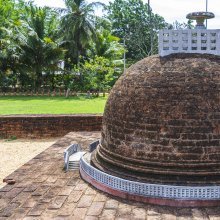Yupa, Yūpa: 22 definitions
Introduction:
Yupa means something in Buddhism, Pali, Hinduism, Sanskrit, the history of ancient India, Marathi, Hindi. If you want to know the exact meaning, history, etymology or English translation of this term then check out the descriptions on this page. Add your comment or reference to a book if you want to contribute to this summary article.
Alternative spellings of this word include Yoop.
Images (photo gallery)
In Hinduism
Purana and Itihasa (epic history)
Source: archive.org: Shiva Purana - English TranslationYūpa (यूप) refers to the “sacrificial stake”, according to the Śivapurāṇa 2.4.6 (“The miraculous feat of Kārttikeya”).—Accordingly, after the Brahmin named Nārada spoke to Kumāra (Kārttikeya): “[...] Then [Vīrabāhu] went to Vaikuṇṭha where he saw the powerful goat working havoc with the sacrificial stake tied to its neck (gala-yūpa). The hero dragged it catching hold of its horns and brought it quickly before his lord even as it was bleating loudly. On seeing it, lord Kārttikeya who could carry the weighty universe, and the worker of great miracles, quickly rode on it. [...]”.
Source: Cologne Digital Sanskrit Dictionaries: The Purana IndexYūpa (यूप).—A sacrificial post;1 circumambulation of the, leads to the fruit of Vājapeya;2 in the Gaura hill on the banks of the Ganges where Indra made many sacrifices;3 near Brahmatīrtha where Brahmā performed sacrifice and planted a Yūpa.4
- 1) Vāyu-purāṇa 30. 148; 94. 17; 97. 28; 106. 43.
- 2) Ib. 111. 31-2.
- 3) Brahmāṇḍa-purāṇa II. 18. 28.
- 4) Vāyu-purāṇa 111. 31.

The Purana (पुराण, purāṇas) refers to Sanskrit literature preserving ancient India’s vast cultural history, including historical legends, religious ceremonies, various arts and sciences. The eighteen mahapuranas total over 400,000 shlokas (metrical couplets) and date to at least several centuries BCE.
Vastushastra (architecture)
Source: McGill: The architectural theory of the MānasāraYūpa (यूप).—The basic iconic piece that the sthāpaka made and installed was the yūpa, which, in the fire-sacrifice ritual complex, was the post erected at its site to tie the victim and considered in the Atharva Vedic tradition as skambha, world-pillar.

Vastushastra (वास्तुशास्त्र, vāstuśāstra) refers to the ancient Indian science (shastra) of architecture (vastu), dealing with topics such architecture, sculpture, town-building, fort building and various other constructions. Vastu also deals with the philosophy of the architectural relation with the cosmic universe.
Dharmashastra (religious law)
Source: Sacred Texts: The Grihya Sutras, Part 2 (SBE30)Yūpa (यूप) or “sacrificial post” for fastening sacrificial animals is made of Khadira wood. But if a post made of wood is not strong enough to hold the animal, then an iron post is to be used, the object being the fastening of the animal, while the material is of less consequence.

Dharmashastra (धर्मशास्त्र, dharmaśāstra) contains the instructions (shastra) regarding religious conduct of livelihood (dharma), ceremonies, jurisprudence (study of law) and more. It is categorized as smriti, an important and authoritative selection of books dealing with the Hindu lifestyle.
Shaivism (Shaiva philosophy)
Source: Brill: Śaivism and the Tantric TraditionsYūpa (यूप) refers to the “sacrificial pillar”, according to the Mattavilāsaprahasana.—Accordingly, as the Kāpālika cries out: “My darling, look. This pub resembles the Vedic sacrificial ground. For its signpost (dhvajastambha) resembles the sacrificial pillar (yūpa); in this case alcohol is the Soma, drunkards are the sacrificial priests, the wine glasses are the special cups for drinking Soma, the roasted meat and other appetizers are the fire oblations, the drunken babblings are the sacrificial formulae, the songs are the Sāman-hymns, the pitchers are the sacrificial ladles, thirst is the fire and the owner of the pub is the patron of the sacrifice”

Shaiva (शैव, śaiva) or Shaivism (śaivism) represents a tradition of Hinduism worshiping Shiva as the supreme being. Closely related to Shaktism, Shaiva literature includes a range of scriptures, including Tantras, while the root of this tradition may be traced back to the ancient Vedas.
In Buddhism
Mahayana (major branch of Buddhism)
Source: De Gruyter: A Buddhist Ritual Manual on AgricultureYūpa (यूप) refers to a “pillar”, according to the Vajratuṇḍasamayakalparāja, an ancient Buddhist ritual manual on agriculture from the 5th-century (or earlier), containing various instructions for the Sangha to provide agriculture-related services to laypeople including rain-making, weather control and crop protection.—Accordingly, “Now the Bhagavān was residing in the abode of Brahmā. [...] The Bhagavān had a body ornamented with a net of ten million million thousand rays. He was blazing brightly like a golden pillar (suvarṇa-yūpa). He was brilliant like the Sun, displayed the thirty-two marks of beauty and the eighty minor marks of beauty. He was embellished with a radiance measuring a fathom. He had the body of a Tathāgata, extremely pure, extremely spotless and brilliant”.

Mahayana (महायान, mahāyāna) is a major branch of Buddhism focusing on the path of a Bodhisattva (spiritual aspirants/ enlightened beings). Extant literature is vast and primarely composed in the Sanskrit language. There are many sūtras of which some of the earliest are the various Prajñāpāramitā sūtras.
India history and geography
Source: Cologne Digital Sanskrit Dictionaries: Indian Epigraphical GlossaryYūpa.—(EI 2, 24, 33), sacrificial pillar; it was sometimes made of stone and inscribed. Note: yūpa is defined in the “Indian epigraphical glossary” as it can be found on ancient inscriptions commonly written in Sanskrit, Prakrit or Dravidian languages.

The history of India traces the identification of countries, villages, towns and other regions of India, as well as mythology, zoology, royal dynasties, rulers, tribes, local festivities and traditions and regional languages. Ancient India enjoyed religious freedom and encourages the path of Dharma, a concept common to Buddhism, Hinduism, and Jainism.
Languages of India and abroad
Pali-English dictionary
Source: BuddhaSasana: Concise Pali-English Dictionaryyūpa : (m.) a sacrificial post.
Source: Sutta: The Pali Text Society's Pali-English DictionaryYūpa, (Vedic yūpa) 1. a sacrificial post D. I, 141; A. IV, 41; J. IV, 302; VI, 211; Miln. 21 (dhamma°); SnA 321, 322; DA. I, 294.—2. a pāsāda, or palace Th. 1, 163=J. II, 334.

Pali is the language of the Tipiṭaka, which is the sacred canon of Theravāda Buddhism and contains much of the Buddha’s speech. Closeley related to Sanskrit, both languages are used interchangeably between religions.
Marathi-English dictionary
Source: DDSA: The Molesworth Marathi and English Dictionaryyūpa (यूप).—m S A pillar or post in general.
Source: DDSA: The Aryabhusan school dictionary, Marathi-Englishyūpa (यूप).—m A pillar or post in general.
Marathi is an Indo-European language having over 70 million native speakers people in (predominantly) Maharashtra India. Marathi, like many other Indo-Aryan languages, evolved from early forms of Prakrit, which itself is a subset of Sanskrit, one of the most ancient languages of the world.
Sanskrit dictionary
Source: DDSA: The practical Sanskrit-English dictionaryYūpa (यूप).—[yu-pak pṛṣo° dīrghaḥ; cf. Uṇādi-sūtra 3.27]
1) A sacrificial post (usually made of bamboo or Khadira wood) to which the victim is fastened at the time of immolation; अपेक्ष्यते साधुजनेन वैदिकी श्मशानशूलस्य न यूपसत्क्रिया (apekṣyate sādhujanena vaidikī śmaśānaśūlasya na yūpasatkriyā) Kumārasambhava 5.73; ग्रामेष्वात्मविसृष्टेषु यूपचिह्नेषु यज्वनाम् (grāmeṣvātmavisṛṣṭeṣu yūpacihneṣu yajvanām) R.1.44.
2) A trophy.
Derivable forms: yūpaḥ (यूपः).
Source: Cologne Digital Sanskrit Dictionaries: Shabda-Sagara Sanskrit-English DictionaryYūpa (यूप).—mn.
(-paḥ-paṃ) 1. A sacrificial post, a pillar usually made of bamboos, or the wood of the K'hadira, to which the victim at a sacrifice is bound. 2. A trophy, a column erected in honour of a victory. E. yu to bind, (the victim,) pa Unadi aff.
Source: Cologne Digital Sanskrit Dictionaries: Benfey Sanskrit-English DictionaryYūpa (यूप).—I. m. and n. A sacrificial post, Mahābhārata 7, 2266. Ii. m. A trophy.
Source: Cologne Digital Sanskrit Dictionaries: Cappeller Sanskrit-English DictionaryYūpa (यूप).—[masculine] post, [especially] the stake to which the sacrificial victim is fastened, poss. vant†.
Source: Cologne Digital Sanskrit Dictionaries: Monier-Williams Sanskrit-English Dictionary1) Yūpa (यूप):—m. ([probably] [from] √yup; but according to, [Uṇādi-sūtra iii, 27], [from] √2. yu) a post, beam, pillar, ([especially]) a smooth post or stake to which the sacrificial victim is fastened, any sacrificial post or stake (usually made of bamboos or Khadira wood; in [Rāmāyaṇa i, 13, 24; 25], where the horse sacrifice is described, 21 of these posts are set up, 6 made of Bilva, 6 of Khadira, 6 of Palāśa, one of Uḍumbara, one of Śleṣmātaka, and one of Deva-dāru), [Ṛg-veda] etc. etc.
2) a column erected in honour of victory, a trophy (= jaya-stambha), [cf. Lexicographers, esp. such as amarasiṃha, halāyudha, hemacandra, etc.]
3) Name of a [particular] conjunction of the class Ākṛti-yoga (id est. when all the planets are situated in the 1st, 2nd, 3rd and 4th houses), [Varāha-mihira’s Bṛhat-saṃhitā]
Source: Cologne Digital Sanskrit Dictionaries: Yates Sanskrit-English DictionaryYūpa (यूप):—[(paḥ-paṃ)] 1. m. n. A sacrificial post, a trophy, column of victory.
Source: DDSA: Paia-sadda-mahannavo; a comprehensive Prakrit Hindi dictionary (S)Yūpa (यूप) in the Sanskrit language is related to the Prakrit words: Jūa, Jūya.
[Sanskrit to German]
Sanskrit, also spelled संस्कृतम् (saṃskṛtam), is an ancient language of India commonly seen as the grandmother of the Indo-European language family (even English!). Closely allied with Prakrit and Pali, Sanskrit is more exhaustive in both grammar and terms and has the most extensive collection of literature in the world, greatly surpassing its sister-languages Greek and Latin.
Hindi dictionary
Source: DDSA: A practical Hindi-English dictionaryYūpa (यूप) [Also spelled yoop]:—(nm) the post with which the sacrificial animal in a '[yajña]' is tied; ~[pikā] a toggle.
...
Kannada-English dictionary
Source: Alar: Kannada-English corpusYūpa (ಯೂಪ):—
1) [noun] a post in a sacrificial place to which the animal to be sacrificed is tied.
2) [noun] a pillar erected in memory of a victory achieved in a war.
3) [noun] (astrol.) a particular conjugation, in which all astrological planets are situated in the first four mansions from the birth-mansion at the time of one’s birth.
Kannada is a Dravidian language (as opposed to the Indo-European language family) mainly spoken in the southwestern region of India.
See also (Relevant definitions)
Starts with (+23): Yupacchedana, Yupadaru, Yupadhvaja, Yupadru, Yupadruma, Yupadvipa, Yupagra, Yupahastin, Yupahuti, Yupaikadashini, Yupaka, Yupakambha, Yupakarmanyaya, Yupakarna, Yupakataka, Yupakavant, Yupakavat, Yupakeshin, Yupaketu, Yupakhya.
Ends with (+15): Anuyupa, Ashvayupa, Atmayupa, Ayupa, Brahmayupa, Cashalayupa, Chyupa, Cityayupa, Cyupa, Dharmayupa, Dikshayupa, Ekayupa, Galayupa, Homayupa, Kagyupa, Keyupa, Manayupa, Mancayupa, Mrityupa, Pashubandhayupa.
Full-text (+124): Yupakarna, Yupalakshya, Yupakataka, Yathayupam, Anuyupam, Yupadru, Yupadhvaja, Yupadruma, Yathakayam, Yupavraska, Yupaketu, Vraska, Yupavaha, Yupakhya, Agnishtha, Yupaksha, Rashanasammita, Yupahuti, Yupocchraya, Yupagra.
Relevant text
Search found 44 books and stories containing Yupa, Yūpa; (plurals include: Yupas, Yūpas). You can also click to the full overview containing English textual excerpts. Below are direct links for the most relevant articles:
The Agnistoma Somayaga in the Shukla Yajurveda (by Madan Haloi)
Part 5.3: Animal sacrifie in honour of Agni (savanīya-paśuyāga) < [Chapter 4 - The Agniṣṭoma Ritual]
Part 2.6: The Paśuyāga Sacrifice < [Chapter 2 - An Introduction to the Ritualistic Religion of the Vedas]
Part 4.10: Cutting and raising of the sacrificial post < [Chapter 4 - The Agniṣṭoma Ritual]
Satapatha-brahmana (by Julius Eggeling)
Kāṇḍa III, adhyāya 6, brāhmaṇa 4 < [Third Kāṇḍa]
Kāṇḍa III, adhyāya 7, brāhmaṇa 1 < [Third Kāṇḍa]
Kāṇḍa I, adhyāya 6, brāhmaṇa 2 < [First Kāṇḍa]
Rig Veda (translation and commentary) (by H. H. Wilson)
Mahabharata (English) (by Kisari Mohan Ganguli)
Ramayana (by Manmatha Nath Dutt)
Chapter XIV < [Book 1 - Bāla-kāṇḍa]
Pallava period (Social and Cultural History) (by S. Krishnamurthy)
Composition of army and system of warfare < [Chapter 4 - Material Culture of the People]
Asvamedha-yaga < [Chapter 3 - Socio-Religious Life]
Related products




